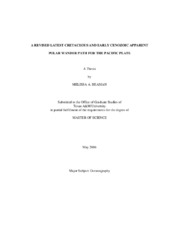| dc.description.abstract | The apparent polar wander path (APWP) for the Pacific plate during the Late
Cretaceous and Early Cenozoic has been constrained primarily by seamount magnetic
anomaly inversions and seafloor magnetic anomaly skewness. The reliability of these
data types is uncertain and data are too sparse to provide a consistent or detailed APWP.
In an effort to refine the Pacific APWP, we collected a larger, more diverse data set that
allowed for the calculation of new mean paleomagnetic poles for the latest Cretaceous
and Paleogene. We combined four types of data including sediment core
paleocolatitudes, basalt core paleocolatitudes, seamount magnetic anomaly inversion
declinations, and effective inclinations from magnetic anomaly skewness calculations.
This diverse data set yields paleomagnetic poles that are less affected by bias from any
particular data type. We found reasonably good agreement between data types and
calculated five mean paleomagnetic poles representing the Oligocene (30 Ma), Late (39
Ma) and Early (49 Ma) Eocene, and Paleocene (61 Ma) epochs and the Maastrichtian
(68 Ma) stage. Though a significant percentage of the data are from azimuthallyunoriented
cores, which do not provide constraint on paleodeclination, a wide
distribution of sites and the use of declination data from seamount anomaly inversions gave relatively good control on pole paleolongitude. The large numbers of data in our
calculations allow for reasonably compact uncertainty bounds and the overall agreement
among most data implies insignificant systematic errors in the data set. The greatest
disagreement among data occurs due to a divergence between poles from anomaly
skewness and other data types prior to 55 Ma. As a whole, the new APWP implies
northward Pacific plate drift. However, this motion is punctuated with a stillstand from
the Late Cretaceous (~80 Ma) until the middle Eocene, (~49 Ma). This stillstand
suggests a lack of northward Pacific plate motion during this time, counter to most
accepted models. This APWP is consistent with paleomagnetic results from the
Emperor Chain that indicate the Hawaiian hotspot moved south during formation of the
Emperor Chain, but it implies an amount of motion slightly greater than that previously
proposed for hotspot drift. | en |


